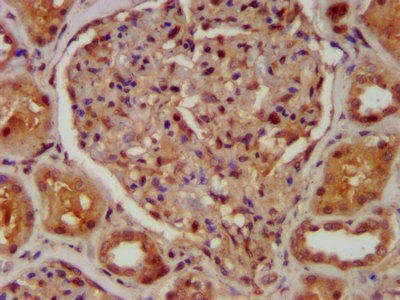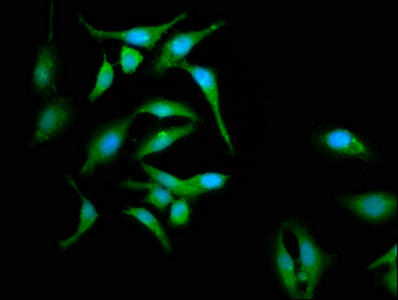Description
| Antibody Name: | CABP4 Antibody (PACO57684) |
| Antibody SKU: | PACO57684 |
| Size: | 50ug |
| Host Species: | Rabbit |
| Tested Applications: | ELISA, IHC, IF |
| Recommended Dilutions: | ELISA:1:2000-1:10000, IHC:1:200-1:500, IF:1:50-1:200 |
| Species Reactivity: | Human |
| Immunogen: | Recombinant Human Calcium-binding protein 4 protein (1-107AA) |
| Form: | Liquid |
| Storage Buffer: | Preservative: 0.03% Proclin 300 Constituents: 50% Glycerol, 0.01M PBS, pH 7.4 |
| Purification Method: | >95%, Protein G purified |
| Clonality: | Polyclonal |
| Isotype: | IgG |
| Conjugate: | Non-conjugated |
 | IHC image of PACO57684 diluted at 1:400 and staining in paraffin-embedded human kidney tissue performed on a Leica BondTM system. After dewaxing and hydration, antigen retrieval was mediated by high pressure in a citrate buffer (pH 6.0). Section was blocked with 10% normal goat serum 30min at RT. Then primary antibody (1% BSA) was incubated at 4°C overnight. The primary is detected by a biotinylated secondary antibody and visualized using an HRP conjugated SP system. |
 | Immunofluorescence staining of Hela cells with PACO57684 at 1:133, counter-stained with DAPI. The cells were fixed in 4% formaldehyde, permeabilized using 0.2% Triton X-100 and blocked in 10% normal Goat Serum. The cells were then incubated with the antibody overnight at 4°C. The secondary antibody was Alexa Fluor 488-congugated AffiniPure Goat Anti-Rabbit IgG(H+L). |
| Background: | Involved in normal synaptic function through regulation of Ca(2+) influx and neurotransmitter release in photoreceptor synaptic terminals and in auditory transmission. Modulator of CACNA1D and CACNA1F, suppressing the calcium-dependent inactivation and shifting the activation range to more hyperpolarized voltages (By similarity). |
| Synonyms: | Calcium-binding protein 4 (CaBP4), CABP4 |
| UniProt Protein Function: | CABP4: Involved in normal synaptic function through regulation of Ca(2+) influx and neurotransmitter release in photoreceptor synaptic terminals and in auditory transmission. Modulator of CACNA1D and CACNA1F, suppressing the calcium-dependent inactivation and shifting the activation range to more hyperpolarized voltages. Defects in CABP4 are the cause of congenital stationary night blindness type 2B (CSNB2B). Congenital stationary night blindness is a non-progressive retinal disorder characterized by impaired night vision. 2 isoforms of the human protein are produced by alternative splicing.Protein type: Calcium-bindingChromosomal Location of Human Ortholog: 11q13.2Cellular Component: extracellular region; terminal button; synapse; cytosolMolecular Function: calcium ion bindingBiological Process: visual perception; retinal cone cell development; phototransduction; photoreceptor cell morphogenesis; signal transduction; retinal bipolar neuron differentiationDisease: Night Blindness, Congenital Stationary, Type 2b |
| UniProt Protein Details: | |
| NCBI Summary: | This gene encodes a member of the CABP family of calcium binding protein characterized by four EF-hand motifs. Mutations in this gene are associated with congenital stationary night blindness type 2B. Three transcript variants encoding two different isoforms have been found for this gene. [provided by RefSeq, Jul 2014] |
| UniProt Code: | P57796 |
| NCBI GenInfo Identifier: | 20178284 |
| NCBI Gene ID: | 57010 |
| NCBI Accession: | P57796.2 |
| UniProt Secondary Accession: | P57796,Q8N4Z2, Q8WWY5 |
| UniProt Related Accession: | P57796 |
| Molecular Weight: | 19,600 Da |
| NCBI Full Name: | Calcium-binding protein 4 |
| NCBI Synonym Full Names: | calcium binding protein 4 |
| NCBI Official Symbol: | CABP4 |
| NCBI Official Synonym Symbols: | CSNB2B |
| NCBI Protein Information: | calcium-binding protein 4 |
| UniProt Protein Name: | Calcium-binding protein 4 |
| UniProt Synonym Protein Names: | |
| Protein Family: | Calcium-binding protein |
| UniProt Gene Name: | CABP4 |
| UniProt Entry Name: | CABP4_HUMAN |






